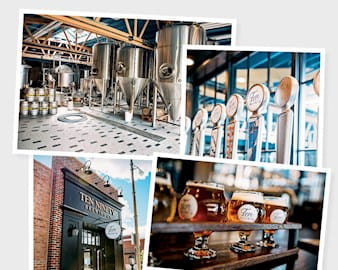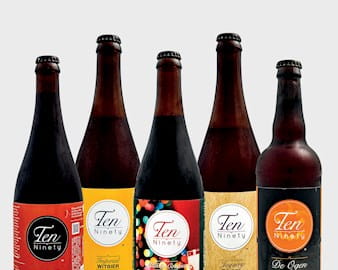
Jamie Hoban, ’02, turned a home-brewing hobby into a burgeoning craft beer company.
- By
- October 10, 2016
- Entrepreneurship

In the back of an Illinois-based taproom, Jamie Hoban, ’02, stands next to a cluster of wooden pallets. Heavy-duty shrink-wrap envelops each of the pallets, which are stacked in rows as high as a basketball hoop in order to protect their fragile contents: thousands of empty beer bottles. These vessels won’t be empty for long. Hoban and his business partners, Brian Schafer and Andy Smith, will soon fill them with Angry Dragon Pale Ale, Pink Tie Saison, Milk & Cookies, and other wildly inventive (and wildly tasty) beers made by their growing business, Ten Ninety Brewing Company.
Ten Ninety takes a culinary approach to brewing. Hoban and his partners draw their inspiration for beer recipes from the flavor profiles in food, combining ingredients like green tea and lemon grass, or even cayenne pepper and pomegranate. The result is a complex alcoholic beverage that’s crafted specifically to pair with specific cuisines. Hence Ten Ninety’s slogan: “Craft Beer Elevated.”
“I love beer’s flexibility,” Hoban said. “Wine is determined by the grapes and the terroir—where they’re grown. With beer, it’s an open canvas. There’s obviously a science to brewing, but there’s also an art to it—to creating the best flavor profiles. And the best breweries have the best artists.”
So why should consumers reach for a Ten Ninety beer instead of wine when looking for the perfect pairing partner? For one thing, Hoban notes, beer is carbonated. “Carbonation can sometimes act as a palate cleanser, resetting your palate for the next bite so you’re not overloading on one single flavor,” he said.

At Ten Ninety, Hoban and his partners target a higher “original gravity” in many of their beers by using more grain and other fermentable ingredients, such as honey or jaggery sugar. The result is generally a beer with higher alcohol content that’s not only complex, but also versatile in pairing with a variety of different foods or cuisines.
“In this marketplace, the consumer wants something different, something new,” Hoban said. “We’re trying to give that to them.”
The concept of craft beer—made by a small brewery using traditional methods and independent of a noncraft brewing company, such as Anheuser-Busch InBev—didn’t take shape in the United States until the late 1970s. Many enthusiasts and historians credit today’s craft-beer craze—a $22.3 billion market employing 122,000 people across 4,269 craft breweries in the United States—with the federal legalization of home brewing in 1978, which inspired Hoban’s forebears to create their own craft brewing companies.
In 2002, Hoban was nearing completion of the Evening MBA Program, and he began home brewing with his partners. “A lot of home brewers will clone their favorite beers, but the three of us didn’t do that,” he said. “Why would we spend eight hours brewing something we could just walk down to the liquor store and buy ourselves for $7? We started brewing beers we wanted to try. We started experimenting.”
After winning a couple of local competitions, including one in which their flagship Imperial Witbier beat craft-beer behemoths Metropolitan and Goose Island, the three friends discussed commercializing their hobby. In 2013, they struck a contract-brewing partnership with Zion, Illinois–based Big Chicago Brewing, which they acquired in 2014. Two years later, they opened their taproom in Glenview, Illinois, to be a “community contact point for customers,” Hoban said. More than a dozen of their beers can be purchased at retailers across Wisconsin, Illinois, and Michigan, with further Midwest expansion in the works.
“In this marketplace, the consumer wants something different, something new.”
Hoban and his partners want to scale their business and distribute nationally too. Earlier this year, they partnered with Seattle-based Tavour, an online company that provides its members with direct access to award-winning craft beers from around the country—such as Ten Ninety’s.
“It’s a good way to test some of those West Coast markets without a big commitment,” said Hoban, whose responsibilities at Ten Ninety include branding, working with suppliers, and formulating the strategy behind releasing new products into the market.
Scaling the Ten Ninety product into new markets requires a high level of risk and analytical discipline, which Hoban said he learned at Booth. “Every class I took, there was some very heavy analytical modeling involved, especially with professor Kevin M. Murphy, PhD ’86 (Economics),” he said. “I also learned how to look past the numbers. The numbers aren’t the answer. They are a tool to help me arrive at a decision.”
Most foodies have encountered a sommelier, a trained wine expert who can recommend the best wine to pair with your food. In the beer world, the equivalent expertise is found in the less familiar cicerone. These beer experts can earn three levels of cicerone certification, topping off at master cicerone—a certification that Hoban said is very difficult to attain (he’s only at the first level—certified beer server). So which is harder to earn, a Booth MBA or a master cicerone certification? Hoban laughed and said, “probably master-level cicerone.”
Want to become a home-brewing master? Hoban shares some tips to get started.
How to study up
Hoban: John Palmer’s How to Brew is the most approachable book on home brewing I’ve ever seen. There are other books that are more technical, like The Beer Bible by Jeff Alworth, but this one is the best for beginners.
What newbies should consider
Hoban: Sanitation. If you don’t sanitize properly by cleaning everything on a regular basis, you’re asking to ruin an entire batch of beer.
The equipment you’ll need
Hoban: Two pots, one to boil water and the second to put the wort in. I recommend 10-gallon pots. You also need a heat source (your stovetop or an outdoor propane burner), fermenters, tubing, a mashing apparatus, bottles, caps, and a press to put the caps on. You can also use a corny keg in place of bottles and caps.
What you should expect to spend on equipment
Hoban: You could spend $1,000 or more if you want a more advanced system, but you don’t have to spend more than a couple hundred dollars to start.
We asked Hoban to be our personal cicerone for five fall-inspired dishes.

Grilled hamburger with lettuce, mustard, and red onion, and a side of sweet potato fries
Pick: Imperial Porter
Why: “It’s brewed with cayenne pepper and pomegranate. As you’re eating the burger and getting the caramelized flavors from the onion and meat, the heat from the cayenne pepper will pull it all together.”
Pumpkin pie
Pick: Milk & Cookies
Why: You’d want something thick and creamy. Our Milk & Cookies is a stout brewed with ginger and some holiday spices. It will pair well with the spices in pumpkin pie.”
Butternut squash risotto
Pick: De Ogen
Why: “Our pumpkin saison is not overly sweet. It has more earthy qualities. The lively carbonation from the saison is going to cut through a lot of that creamy risotto richness.”
Pineapple cranberry chicken with broccoli rabe
Pick: Jaggery Tripel
Why: “Because of the yeast, Belgian tripels have a little hint of sulfur and earthiness to them, which will wrap right around the broccoli rabe and bring the whole dish together.”
Lemon-garlic kale salad
Pick: Imperial Witbier
Why: Our witbier is a bigger beer. It’s 10 percent alcohol, so it can take on the garlic. You’ll also get a little bit of honey and residual sweetness for balance.”

Giuliano Testa, ’11 (XP-80), is a pioneer of uterus transplants in the United States—and hopes that his program can continue to help make inroads into infertility treatment.
Innovating a Solution for Infertility
Leading a community development corporation, Hope Knight, ’96 (XP-65), aims to write a new future for Jamaica in Queens, New York.
Renewing a Storied New York Neighborhood
Planned by passionate volunteers, alumni-led forums around the globe have brought graduates together to learn, recharge, and grow.
Connecting Alumni Worldwide